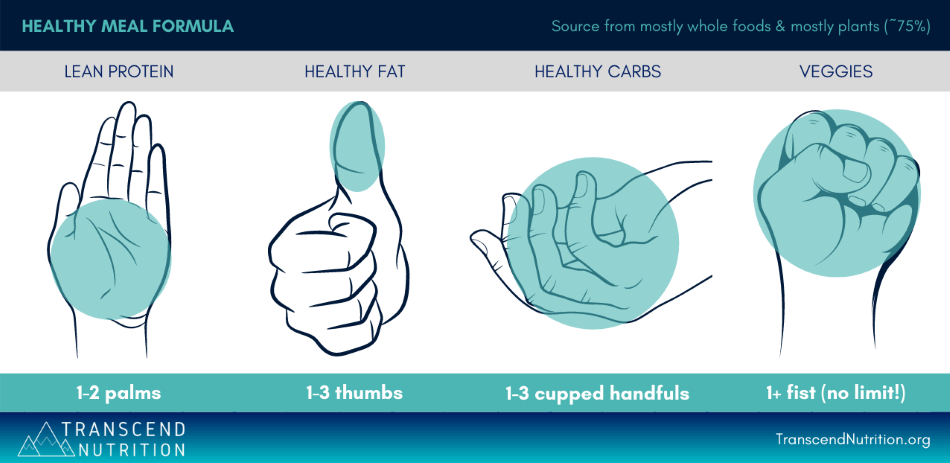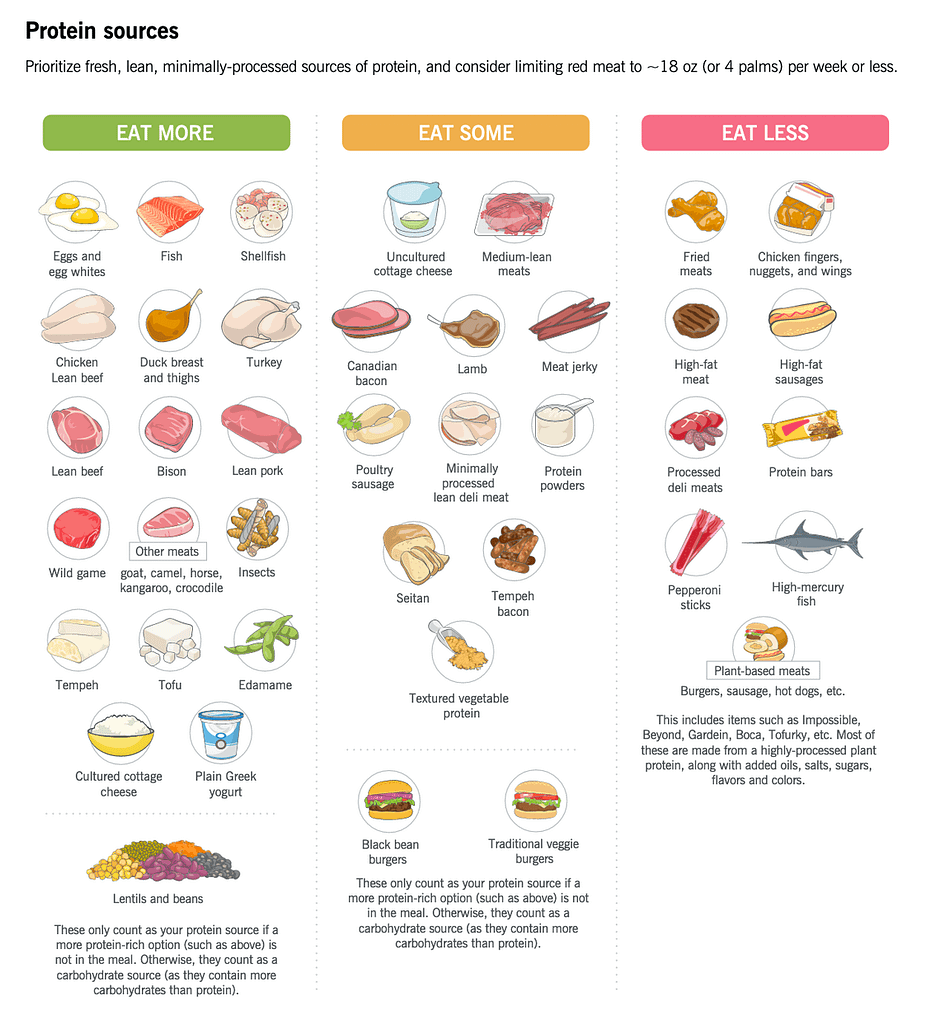Are you ever scrambling in the kitchen last minute, trying to figure out how to put together a healthy meal for yourself and your family? Or, are you tired of having to plan a menu for the week on weekends from an endless list of gourmet recipes? Well – I’m going to help simplify cooking a healthy dinner for you with my easy healthy meal formula!
In this post, you will learn some basic concepts and how to put them into practice!
Baseline Healthy Meal Formula
While everyone varies in their goals and preferences, this is the baseline formula that can be applied to most people. It is assuming you prefer a balanced macronutrient intake, that your activity level is light, and that you eat 3 meals a day.
Moreover, as there is never truly a one-size-fits-all approach to diet, I suggest my quick-start coaching if you are looking for a custom assessment or you can calculate a good baseline with the calculator here: The Ultimate Macro Calculator (precisionnutrition.com).
With this formula, you also want to focus on getting most of your intake from whole, unprocessed, or minimally processed foods.
According to my healthy meal formula, for each meal and for each individual, you want to focus on getting the following. Click the type of food to jump to the suggested list of foods for that food type.
- 1-2 palms of lean protein
- 1-3 thumbs of healthy fat
- One to 3 cupped handfuls of complex carbohydrates
- at least one fist of veggies (as much as you want, really)
Read on for what each of these means and how to estimate amounts. For TLDR, here is the formula as an explanatory graphic:

What Are Whole Foods?
In one of my latest articles, The Importance of Eating Clean As An Entrepreneur, I define whole foods as foods close to what they looked like when they came out of the ground (plant foods) or look similar to before they were slaughtered (animal foods).
They include very minimal processing, if any, and do not include any engineered ingredients. The ingredients are simple and pronounceable, often recognizable, and none of them sound like they may be involved in a science experiment.
Lean Protein
Prioritize lean, minimally-processed sources of protein and limit red meat to less than four palms a week. I also encourage choosing whole food plant-based protein over other sources of protein.
It’s an easy way to reduce saturated fat intake and get an extended set of nutrients. For more extensive info and a list of plant-based proteins, check out my article, Sources of Plant-based Protein. The items in the list below can also be found here in a printable protein grocery list by Precision nutrition.

Animal-based Protein
- Beef, bison, and buffalo
- Lean cuts of pork and boar
- Lamb
- Goat
- Wild game, such as elk, venison, caribou, moose
- Poultry such as chicken, turkey, duck, pigeon
- Fish
- Seafood such as shrimp, squid, octopus, lobster, crayfish
- Mollusks such as clams, mussels, scallops, snails (escargots)
- Eggs and egg whites
- Dairies such as cottage cheese or strained Greek yogurt
- Reptiles and amphibians such as snakes, alligators/crocodiles, frog
Plant-based Protein
- Beans, lentils, and legumes
- Tempeh, tofu, or edamame
- Seitan
Protein Supplements
- Protein powder such as whey, casein, egg, bone broth/collagen, cricket, plant-based blends (e.g., pea protein, rice protein, hemp protein)
Vegetables
As far as vegetables are concerned (and fruits for that matter, though in my healthy meal formula they are classified as carbs), a good practice is to rotate them based on their color. Indeed, each color contains different phytonutrients that fight against various diseases and promote optimal health. If you are curious about what colors contain which phytonutrients and their main benefits, check out my recipe and article, Rainbow Charcuterie with Phytonutrient Benefits.
Furthermore, local and raw produce generally retain the most nutrients, but frozen is great too! I would just place preference on fresh or frozen over canned, and if you do buy canned, aim for low sodium. The items in the lists here below can also be found in a printable fruit & vegetable grocery list here by Precision nutrition sorted by color.

Purple & Blue Vegetables
- Eggplant
- Carrots (purple)
- Purple peppers
- Cauliflower (purple)
- Purple asparagus
- Cabbage (purple)
- Purple kale
Orange & Yellow Vegetables
- Winter squash varieties
- Yellow zucchini & summer squash
- Pumpkin
- Yellow & orange peppers
- Yellow & orange carrots
- Orange cauliflower
- Yellow-orange beets
Red & Pink Vegetables
- Beets
- Cabbage (red)
- Red onions
- Red leaf lettuce, radicchio
- Peppers (red)
- Red-skinned radishes
- Tomatoes
- Rhubarb
Green Vegetables
- Beet greens (the tops of beets)
- Broccoli, broccolini, rapini
- Brussels sprouts
- Fresh herbs (e.g. parsley, basil)
- Green beans, snap peas
- Kale
- Okra
- Spinach
- Any other dark leafy green (e.g. turnip greens, collard greens, Swiss chard, arugula)
- Tomatillos
- Zucchini, cucumber (if you eat the peel)
- Romaine lettuce
- Green peppers
- Asparagus
- Cabbage
White Vegetables
- Bean sprouts
- Cauliflower
- Celery
- Daikon radish
- Fennel/anise
- Garlic
- Jicama
- Mushrooms
- Onions, leeks, shallots
- Iceberg lettuce
- White carrots
Healthy Fats
When it comes to fats, try to prioritize monounsaturated sources and avoid saturated fat sources. The chart below will give you an idea of what I mean.
Generally, plant foods are abundant in monounsaturated fats and animal foods typically contain more saturated fats (if they are fatty). “Generally” is italicized because I can think of at least one plant food abundant in saturated fat as well – which is coconut.
* The items below with an asterisk have better fat quality when the animal is grass-fed and/or pastured (depending on the type of animal), rather than conventionally farmed.
Click here, for a printable grocery list of the healthy fats below.

Plant-based healthy fats
- Avocado and avocado oil
- Cacao (dark chocolate)
- Cold-pressed nut and seed oils
- Fresh coconut and coconut oil
- Nuts and seeds
- Nut and seed butters
- Olives and extra virgin olive oil
Supplement
- Omega-3 fatty acid supplement (e.g., fish oil, krill oil, or algae oil)
Animal-based
- Aged cheese*
- Butter*
- Cream*
- Higher-fat dairy*
- Egg yolks*
Healthy Carbohydrates
Carbs are not bad! Try to aim for the carbohydrates that break down in your body slowly, a.k.a. “complex” carbohydrates, which are also less refined and filled with fiber and nutrients. For example, fruit and whole grains fall under this category.
Everyone is different when it comes to consuming flour. If you suspect an intolerance, opt for more whole, intact grains. Some individuals notice a blood sugar spike with more carbohydrate-dense fruits as well. Everyone is different, so just try and be aware of what foods your body likes!
The printable grocery list for healthy carbs can be found here.

Whole-grain carbohydrates
- Whole, intact grains such as brown or wild rice, amaranth, barley, buckwheat, millet, oat groats, quinoa, teff, wheat berries
- Whole or sprouted grain flour foods: bread, bagels, English muffins, pasta, and wraps
- Steel-cut or old-fashioned oats
- Corn
Beans and legumes
- Beans (all)
- Lentils
- Peas
Dairy Considered Carbohydrates
- Kefir, plain
- non-Greek yogurt, plain
Starchy Tuber Carbohydrates
- Potatoes (all colors)
- Sweet potatoes (all colors)
- Taro
- Yuca
Fruits
- Fresh fruit
- Frozen fruit
- Dried fruit, unsweetened
Tweaks for Specific Goals
When it comes to weight loss, your success boils down to creating a consistent energy deficit. This means eating fewer calories than your body is using to move and function. With this in mind, you may have to cut out fats and/or carbohydrates from my baseline healthy meal formula. Ensuring enough protein and vegetables will help you with satiety. Here is an article specific to building your plate for weight loss: My MAGIC FORMULA for Weight Loss + 3 Quick, Tasty Dinner Recipes.
If you are looking to gain muscle, you will want to add more protein. If you are looking for the two simultaneously – you’ll want to add protein and remove fats and/or carbohydrates. Whether you remove fats or carbs is either a matter of preference or context. For example, if you are an endurance athlete looking to lose a little fat, removing fats instead of carbohydrates would be preferable since your body’s preferred energy source is carbohydrates. More on that topic another day… However, you can also get some great tips from my article Meal Prep for Health & Fitness Goals.
Again, there really isn’t a one-size-fits-all approach but you can start with the formula I laid out here and make tweaks depending on your preferences and goals.
Want a more custom approach? I’d love to coach you! I am certified with Precision Nutrition, which is one of the most well-respected nutrition organizations in the world. I offer 1:1 coaching as well as group coaching. Contact me and we can get you started today!
BONUS! How to Create the Perfect Meal
While I have some excellent recipes on this site, you don’t always have to have a well thought out and planned meal. I have an excellent infographic that will help you put together a healthy meal last minute! Click here to download the printable file: How to Create The Perfect Meal.






Pingback: Mediterranean Brussel Sprouts - Clean Cooking with Caitlin